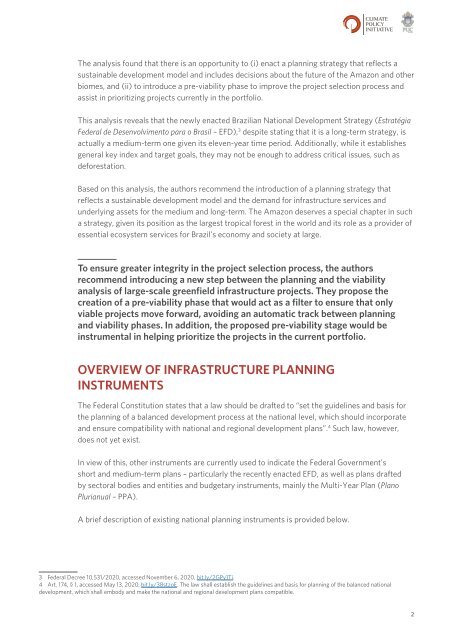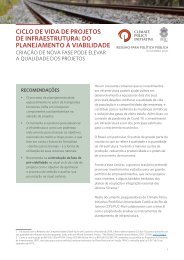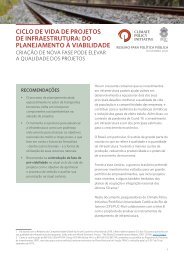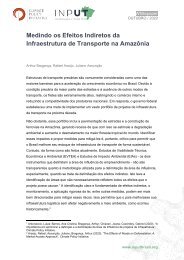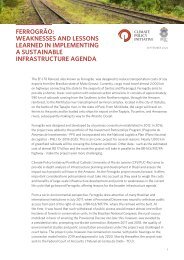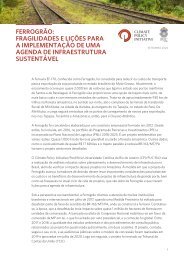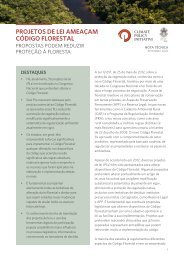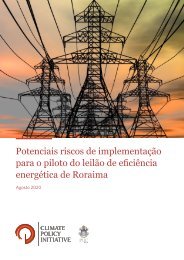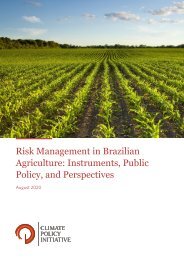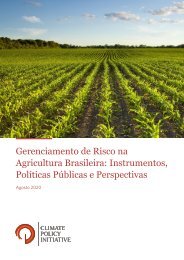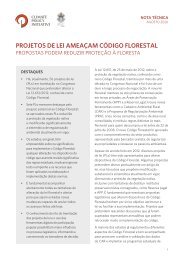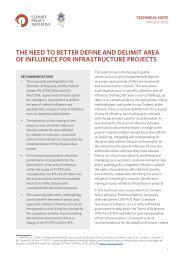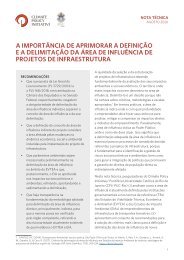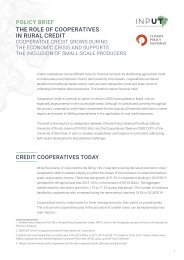Brazil’s Infrastructure Project Life Cycles: from Planning to Viability. Creation of a New Phase May Increase Project Quality
Create successful ePaper yourself
Turn your PDF publications into a flip-book with our unique Google optimized e-Paper software.
The analysis found that there is an opportunity <strong>to</strong> (i) enact a planning strategy that reflects a<br />
sustainable development model and includes decisions about the future <strong>of</strong> the Amazon and other<br />
biomes, and (ii) <strong>to</strong> introduce a pre-viability phase <strong>to</strong> improve the project selection process and<br />
assist in prioritizing projects currently in the portfolio.<br />
This analysis reveals that the newly enacted Brazilian National Development Strategy (Estratégia<br />
Federal de Desenvolvimen<strong>to</strong> para o Brasil – EFD), 3 despite stating that it is a long-term strategy, is<br />
actually a medium-term one given its eleven-year time period. Additionally, while it establishes<br />
general key index and target goals, they may not be enough <strong>to</strong> address critical issues, such as<br />
deforestation.<br />
Based on this analysis, the authors recommend the introduction <strong>of</strong> a planning strategy that<br />
reflects a sustainable development model and the demand for infrastructure services and<br />
underlying assets for the medium and long-term. The Amazon deserves a special chapter in such<br />
a strategy, given its position as the largest tropical forest in the world and its role as a provider <strong>of</strong><br />
essential ecosystem services for <strong>Brazil’s</strong> economy and society at large.<br />
To ensure greater integrity in the project selection process, the authors<br />
recommend introducing a new step between the planning and the viability<br />
analysis <strong>of</strong> large-scale greenfield infrastructure projects. They propose the<br />
creation <strong>of</strong> a pre-viability phase that would act as a filter <strong>to</strong> ensure that only<br />
viable projects move forward, avoiding an au<strong>to</strong>matic track between planning<br />
and viability phases. In addition, the proposed pre-viability stage would be<br />
instrumental in helping prioritize the projects in the current portfolio.<br />
OVERVIEW OF INFRASTRUCTURE PLANNING<br />
INSTRUMENTS<br />
The Federal Constitution states that a law should be drafted <strong>to</strong> “set the guidelines and basis for<br />
the planning <strong>of</strong> a balanced development process at the national level, which should incorporate<br />
and ensure compatibility with national and regional development plans”. 4 Such law, however,<br />
does not yet exist.<br />
In view <strong>of</strong> this, other instruments are currently used <strong>to</strong> indicate the Federal Government’s<br />
short and medium-term plans – particularly the recently enacted EFD, as well as plans drafted<br />
by sec<strong>to</strong>ral bodies and entities and budgetary instruments, mainly the Multi-Year Plan (Plano<br />
Plurianual – PPA).<br />
A brief description <strong>of</strong> existing national planning instruments is provided below.<br />
3 Federal Decree 10,531/2020, accessed November 6, 2020, bit.ly/2GPy1Ti.<br />
4 Art. 174, § 1, accessed <strong>May</strong> 13, 2020, bit.ly/38stzoE. The law shall establish the guidelines and basis for planning <strong>of</strong> the balanced national<br />
development, which shall embody and make the national and regional development plans compatible.<br />
2


